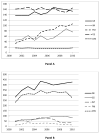Who Performs Colonoscopy? Workforce Trends Over Space and Time
- PMID: 29143383
- PMCID: PMC5889340
- DOI: 10.1111/jrh.12286
Who Performs Colonoscopy? Workforce Trends Over Space and Time
Abstract
Purpose: With the increased availability of colonoscopy to average risk persons due to insurance coverage benefit changes, we sought to identify changes in the colonoscopy workforce. We used outpatient discharge records from South Carolina between 2001 and 2010 to examine shifts over time and in urban versus rural areas in the types of medical providers who perform colonoscopy, and the practice settings in which they occur, and to explore variation in colonoscopy volume across facility and provider types.
Methods: Using an all-payer outpatient discharge records database from South Carolina, we conducted a retrospective analysis of all colonoscopy procedures performed between 2001 and 2010.
Findings: We identified a major shift in the type of facilities performing colonoscopy in South Carolina since 2001, with substantial gains in ambulatory surgery settings (2001: 15, 2010: 34, +127%) versus hospitals (2001: 58, 2010: 59, +2%), particularly in urban areas (2001: 12, 2010: 27, +125%). The number of internists (2001: 46, 2010: 76) and family physicians (2001: 34, 2010: 106) performing colonoscopies also increased (+65% and +212%, respectively), while their annual procedures volumes stayed fairly constant. Significant variation in annual colonoscopy volume was observed across medical specialties (P < .001), with nongastroenterologists having lower volumes versus gastroenterologists and colon and rectal surgeons.
Conclusions: There have been substantial changes over time in the number of facilities and physicians performing colonoscopy in South Carolina since 2001, particularly in urban counties. Findings suggest nongastroenterologists are meeting a need for colonoscopies in rural areas.
Keywords: ambulatory care; family medicine; health services research; hospitals; physician supply.
© 2017 National Rural Health Association.
Conflict of interest statement
Figures



Similar articles
-
Trends in and factors associated with family physician-performed screening colonoscopies in the United States: 2016-2021.J Rural Health. 2025 Jan;41(1):e12858. doi: 10.1111/jrh.12858. Epub 2024 Jun 26. J Rural Health. 2025. PMID: 38932468 Free PMC article.
-
A statewide program providing colorectal cancer screening to the uninsured of South Carolina.Cancer. 2018 May 1;124(9):1912-1920. doi: 10.1002/cncr.31250. Epub 2018 Feb 7. Cancer. 2018. PMID: 29415338 Free PMC article.
-
Colonoscopy utilization in rural areas by general surgeons: An analysis of the National Ambulatory Medical Care Survey.Am J Surg. 2019 Aug;218(2):281-287. doi: 10.1016/j.amjsurg.2019.02.009. Epub 2019 Feb 13. Am J Surg. 2019. PMID: 30791993
-
High quality of screening colonoscopy in Austria is not dependent on endoscopist specialty or setting.Endoscopy. 2015 Mar;47(3):207-16. doi: 10.1055/s-0034-1390910. Epub 2014 Nov 20. Endoscopy. 2015. PMID: 25412094
-
Quality of colonoscopy services for physicians in the Iowa research network.Fam Med. 2012 Mar;44(3):164-70. Fam Med. 2012. PMID: 22399478
Cited by
-
Safety considerations with the current ambulatory trends: more complicated procedures and more complicated patients.Korean J Anesthesiol. 2023 Oct;76(5):400-412. doi: 10.4097/kja.23078. Epub 2023 Mar 10. Korean J Anesthesiol. 2023. PMID: 36912006 Free PMC article.
-
Spatial accessibility to colonoscopy and its role in predicting late-stage colorectal cancer.Health Serv Res. 2021 Feb;56(1):73-83. doi: 10.1111/1475-6773.13562. Epub 2020 Sep 20. Health Serv Res. 2021. PMID: 32954527 Free PMC article.
-
Trends in spatial access to colonoscopy in South Carolina, 2000-2014.Spat Spatiotemporal Epidemiol. 2021 Jun;37:100414. doi: 10.1016/j.sste.2021.100414. Epub 2021 Mar 6. Spat Spatiotemporal Epidemiol. 2021. PMID: 33980409 Free PMC article.
-
Trends in and factors associated with family physician-performed screening colonoscopies in the United States: 2016-2021.J Rural Health. 2025 Jan;41(1):e12858. doi: 10.1111/jrh.12858. Epub 2024 Jun 26. J Rural Health. 2025. PMID: 38932468 Free PMC article.
-
Disparities in Utilization of Medical Specialists for Colonoscopy.Health Equity. 2019 Sep 3;3(1):464-471. doi: 10.1089/heq.2019.0052. eCollection 2019. Health Equity. 2019. PMID: 31501806 Free PMC article.
References
-
- Siegel RL, Miller KD, Jemal A. Cancer statistics, 2015. CA-Cancer J Clin. 2015;65(1):5–29. - PubMed
-
- U S. Preventive Services Task Force. Screening for colorectal cancer: US preventive services task force recommendation statement. J Amer Med Assoc. 2016;315(23):2564–2575. - PubMed
-
- Levin B, Lieberman DA, McFarland B, et al. Screening and Surveillance for the Early Detection of Colorectal Cancer and Adenomatous Polyps, 2008: A Joint Guideline from the American Cancer Society, the US Multi-Society Task Force on Colorectal Cancer, and the American College of Radiology. CA-Cancer J Clin. 2008;58(3):130–160. - PubMed
-
- Schenck AP, Peacock SC, Klabunde CN, Lapin P, Coan JF, Brown ML. Trends in colorectal cancer test use in the medicare population, 1998–2005. Am J Prev Med. 2009;37(1):1–7. - PubMed
Publication types
MeSH terms
Grants and funding
LinkOut - more resources
Full Text Sources
Other Literature Sources
Medical

